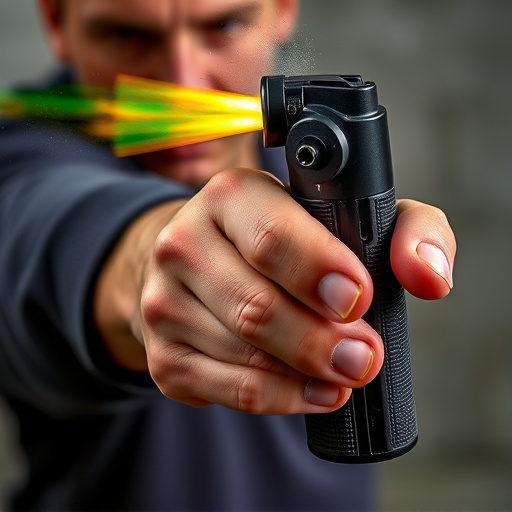This text compares bear spray and personal pepper spray, highlighting their distinct uses and mechanisms. Bear spray, designed for wildlife deterrence, desensitizes bears with a rapid effect, while personal pepper spray utilizes capsaicin to induce inflammation in humans, temporarily incapacitating them. For crowd control, pepper spray is a game-changer due to its targeted impact on vision, breathing, and balance, making it more suitable for human-to-human interactions compared to bear spray's broader reach. Both require proper handling and training but cater to different scenarios based on their unique properties.
“Discover the revolutionary potential of Capsaicin-based crowd control sprays, a non-lethal alternative for law enforcement and self-defense. This article delves into the science behind this powerful ingredient, offering a comparative analysis between bear spray and personal pepper spray. We explore their unique properties, effectiveness, and safety considerations, shedding light on the optimal choice in various scenarios. Understanding these differences is key to making informed decisions regarding crowd control and personal safety.”
- Understanding Capsaicin: The Key Ingredient
- Bear Spray vs Personal Pepper Spray: A Comparative Analysis
- Crowd Control and Safety Considerations
Understanding Capsaicin: The Key Ingredient
Capsaicin, the active ingredient in chili peppers, serves as the cornerstone of many crowd control sprays. Unlike bear spray, which primarily targets the animal’s senses to deter aggression, personal pepper spray relies on capsaicin to induce a potent inflammatory response in humans. This key difference is crucial when considering its application in crowd control scenarios.
While bear spray desensitizes and repels wild animals, personal pepper spray aims to temporarily incapacitate individuals by causing severe irritation and pain. Capsaicin triggers the body’s natural defense mechanisms, leading to tears, coughing, and difficulty breathing. This inflammatory effect creates a safe space for law enforcement or security personnel to control and disperse crowds effectively, making capsaicin-based sprays a game-changer in crowd management strategies compared to traditional bear spray.
Bear Spray vs Personal Pepper Spray: A Comparative Analysis
When it comes to personal protection, choosing between bear spray and personal pepper spray can be a tough decision. Both serve as powerful crowd control tools, but they have distinct properties that make them more suitable for different scenarios. Bear spray, as the name suggests, is designed primarily to deter bears during outdoor activities like hiking or camping. It creates an immediate barrier by causing temporary blindness and pain in the eyes, nose, and throat of the target animal. This makes it ideal for situations where wildlife encounters are a concern.
On the other hand, personal pepper spray is tailored for human-to-human interactions. It disrupts vision, breathing, and balance, rendering the target incapacitated for a short period. This type of spray is widely used by law enforcement and civilians for self-defense against aggressors. Pepper spray’s effectiveness lies in its ability to create a safe distance between individuals without causing permanent harm. The choice between these two depends on the specific needs: wildlife deterrence or personal protection from human threats.
Crowd Control and Safety Considerations
In the realm of crowd control, the choice between bear spray and personal pepper spray is a significant one, each with its unique capabilities and safety considerations. Bear spray, designed for outdoor encounters with aggressive bears, uses capsaicin to create a protective barrier by irritating the eyes and respiratory system. Its wide range and rapid desensitizing effect make it effective against large, unpredictable animals. However, it may not be as precise or targeted as personal pepper spray, which is specifically formulated for direct application to an assailant’s face.
Personal pepper spray, on the other hand, offers a more focused approach to crowd control. It can temporarily incapacitate individuals by causing severe irritation and tearing in the eyes, making it easier to manage or escape from potential threats. Yet, its range is typically shorter than bear spray, and it may not be as effective against large groups or those wearing protective gear. Safety considerations include ensuring proper training in usage, understanding wind patterns to avoid inhaling the spray oneself, and storing and handling the spray correctly to maintain its potency.
In examining bear spray versus personal pepper spray, it’s clear that both have unique applications. Bear spray excels in repelling large, aggressive threats, while personal pepper spray is more effective for individual self-defense against smaller assailants. Considering the specific needs of crowd control and safety, choosing between them depends on the scenario. For outdoor activities and wildlife encounters, bear spray offers a broader range of protection. In close quarters or urban settings, personal pepper spray proves more practical. Understanding the distinctions between these two types of spray enables users to make informed decisions for their safety and security.
